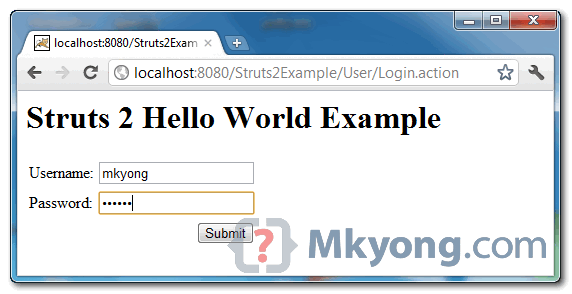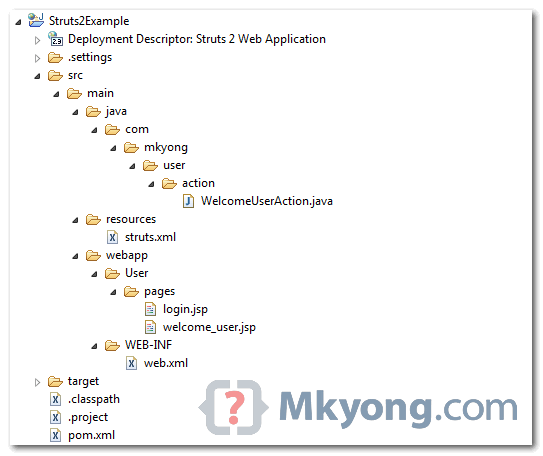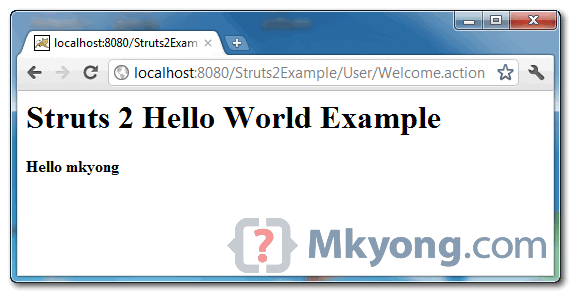In this example, we show you how to create a hello world example in Struts 2.
The following libraries or tools are used :
- Maven 3
- Eclipse 3.7
- Struts 2.3.1.2
1. Final project structure
Let review the final project structure of this tutorial, in case you get lost in later steps.
2. Struts2 dependencies
Use Maven to download the entire Struts2 dependencies. Add “struts2-core” in pom.xml.
File : pom.xml
<project xmlns="http://maven.apache.org/POM/4.0.0"
xmlns:xsi="http://www.w3.org/2001/XMLSchema-instance"
xsi:schemaLocation="http://maven.apache.org/POM/4.0.0
http://maven.apache.org/maven-v4_0_0.xsd">
<modelVersion>4.0.0</modelVersion>
<groupId>com.mkyong.common</groupId>
<artifactId>Struts2Example</artifactId>
<packaging>war</packaging>
<version>com.mkyong.common</version>
<name>Struts2Example Maven Webapp</name>
<url>http://maven.apache.org</url>
<dependencies>
<dependency>
<groupId>junit</groupId>
<artifactId>junit</artifactId>
<version>3.8.1</version>
<scope>test</scope>
</dependency>
<dependency>
<groupId>org.apache.struts</groupId>
<artifactId>struts2-core</artifactId>
<version>2.3.1.2</version>
</dependency>
</dependencies>
<build>
<finalName>Struts2Example</finalName>
<plugins>
<plugin>
<artifactId>maven-compiler-plugin</artifactId>
<version>2.3.2</version>
<configuration>
<source>1.6</source>
<target>1.6</target>
</configuration>
</plugin>
</plugins>
</build>
</project>##3. Convert to Eclipse project
Compile and convert that to Eclipse web project in command prompt :
mvn eclipse:eclipse -Dwtpversion=2.0Review the Eclipse .classpath file, the following Struts2 dependencies are downloaded :
File : .classpath
<classpath>
<classpathentry kind="src" path="src/main/java" including="**/*.java"/>
<classpathentry kind="src" path="src/main/resources" excluding="**/*.java"/>
<classpathentry kind="output" path="target/classes"/>
<classpathentry kind="var" path="M2_REPO/asm/asm/3.3/asm-3.3.jar"/>
<classpathentry kind="var" path="M2_REPO/asm/asm-commons/3.3/asm-commons-3.3.jar"/>
<classpathentry kind="var" path="M2_REPO/asm/asm-tree/3.3/asm-tree-3.3.jar"/>
<classpathentry kind="var" path="M2_REPO/commons-fileupload/commons-fileupload/1.2.2/commons-fileupload-1.2.2.jar" />
<classpathentry kind="var" path="M2_REPO/commons-io/commons-io/2.0.1/commons-io-2.0.1.jar"/>
<classpathentry kind="var" path="M2_REPO/commons-lang/commons-lang/2.5/commons-lang-2.5.jar"/>
<classpathentry kind="var" path="M2_REPO/org/freemarker/freemarker/2.3.18/freemarker-2.3.18.jar"/>
<classpathentry kind="var" path="M2_REPO/javassist/javassist/3.11.0.GA/javassist-3.11.0.GA.jar"/>
<classpathentry kind="var" path="M2_REPO/junit/junit/3.8.1/junit-3.8.1.jar"/>
<classpathentry kind="var" path="M2_REPO/ognl/ognl/3.0.4/ognl-3.0.4.jar"/>
<classpathentry kind="var" path="M2_REPO/org/apache/struts/struts2-core/2.3.1.2/struts2-core-2.3.1.2.jar"/>
<classpathentry kind="lib" path="C:/Program Files/Java/jdk1.6.0_13/lib/tools.jar"/>
<classpathentry kind="var" path="M2_REPO/org/apache/struts/xwork/xwork-core/2.3.1.2/xwork-core-2.3.1.2.jar"/>
<classpathentry kind="con" path="org.eclipse.jdt.launching.JRE_CONTAINER"/>
</classpath>4. JSP view pages
A JSP login page to use the Struts 2 tags to display username and password input fields and submit button.
Fie : login.jsp
<%@ page contentType="text/html; charset=UTF-8"%>
<%@ taglib prefix="s" uri="/struts-tags"%>
<html>
<head></head>
<body>
<h1>Struts 2 Hello World Example</h1>
<s:form action="Welcome">
<s:textfield name="username" label="Username" />
<s:password name="password" label="Password" />
<s:submit />
</s:form>
</body>
</html>File : ·welcome_user.jsp· – A JSP view page to display a welcome message to user.
<%@ page contentType="text/html; charset=UTF-8"%>
<%@ taglib prefix="s" uri="/struts-tags"%>
<html>
<head></head>
<body>
<h1>Struts 2 Hello World Example</h1>
<h2>
Hello
<s:property value="username" />
</h2>
</body>
</html>Both Struts 1 and Struts 2 has very similar UI tags syntax, just a little different in term of naming the HTML elements, for example :
Struts 1
<%@taglib uri="http://struts.apache.org/tags-html" prefix="html"%>
<html:form action="Welcome">
<html:text property="username"/>
</html:form>Struts 2
<%@ taglib prefix="s" uri="/struts-tags" %>
<s:form action="Welcome">
<s:textfield name="username" label="Username"/>
</s:form>5. Action, put all business logic here
A simple Struts2 Action class, it’s used to declared all the business logic inside.
File : WelcomeUserAction.java
package com.mkyong.user.action;
public class WelcomeUserAction{
private String username;
public String getUsername() {
return username;
}
public void setUsername(String username) {
this.username = username;
}
// all struts logic here
public String execute() {
return "SUCCESS";
}
}In Struts2, the Action class is not required to implement any interface or extend any class, but it’s required to create an execute() method to put all the business logic inside and return a String value to tell user where to redirect.
Note
You may see some users implement thecom.opensymphony.xwork2.Actionclass, but it’s totally optional, because thecom.opensymphony.xwork2.Actionis just provide some handy constant values only.
Note
Struts1’s Action class is required to extends theorg.apache.struts.action.Action. But Struts 2 Action class is optional, but you are still allow to implement thecom.opensymphony.xwork2.Actionfor some handy constant values or extends thecom.opensymphony.xwork2.ActionSupportfor some common default Action implementation functions.
5. Struts configuration file
A Strut configuration file to link all stuff together. The xml file name must be “struts.xml”.
File : struts.xml
<?xml version="1.0" encoding="UTF-8" ?>
<!DOCTYPE struts PUBLIC
"-//Apache Software Foundation//DTD Struts Configuration 2.0//EN"
"http://struts.apache.org/dtds/struts-2.0.dtd">
<struts>
<package name="user" namespace="/User" extends="struts-default">
<action name="Login">
<result>pages/login.jsp</result>
</action>
<action name="Welcome" class="com.mkyong.user.action.WelcomeUserAction">
<result name="SUCCESS">pages/welcome_user.jsp</result>
</action>
</package>
</struts>Declare a package and warp the action classes inside, the action classes are self-explanatory, but you may interest at following new tag :
package name=”user”
Just a package name, don’t really care about it.namespace=”/User”
It’s used to match the “/User” URL pattern.
很难想象namespace竟然也控制文件的查找路径。Note
Actually, the Struts2 Namespaces is equivalent to Struts 1 multiple modulesextends=”struts-default”
It means the package is extends thestruts-defaultpackage components and interceptors, which is declared in thestruts-default.xmlfile, located at the root of thestruts2-core.jarfile.
6. web.xml
Configure the Web Application Deployment Descriptor (web.xml) file to integrate Struts2 to your web project.
File web.xml
<!DOCTYPE web-app PUBLIC
"-//Sun Microsystems, Inc.//DTD Web Application 2.3//EN"
"http://java.sun.com/dtd/web-app_2_3.dtd" >
<web-app>
<display-name>Struts 2 Web Application</display-name>
<filter>
<filter-name>struts2</filter-name>
<filter-class>
org.apache.struts2.dispatcher.ng.filter.StrutsPrepareAndExecuteFilter
</filter-class>
</filter>
<filter-mapping>
<filter-name>struts2</filter-name>
<url-pattern>/*</url-pattern>
</filter-mapping>
</web-app>7. Run it
In Struts2, you can access the action class directly with a suffix of .action.
http://localhost:8080/Struts2Example/User/Login.action

http://localhost:8080/Struts2Example/User/Welcome.action
























 549
549

 被折叠的 条评论
为什么被折叠?
被折叠的 条评论
为什么被折叠?








